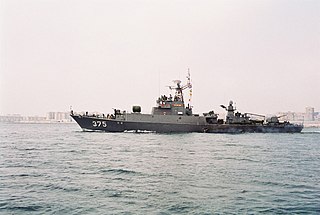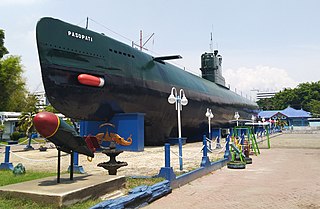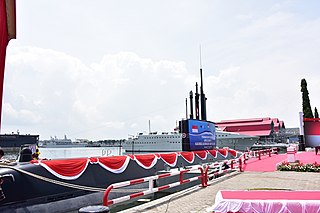
The Shishumar-class vessels are diesel-electric attack submarines, currently in active service with the Indian Navy. These submarines are an Indian variant of the Type 209 submarines developed by the German yard Howaldtswerke-Deutsche Werft (HDW) under the internal designation Type 1500. The first two vessels were built by HDW at Kiel, while the remainder were built at Mazagon Dock Limited (MDL), Mumbai under a technology transfer agreement. The submarines were commissioned between 1986 and 1994. These submarines have a displacement of 1660 tons when surfaced, a speed of 22 knots (41 km/h), and a complement of 40 including eight officers.

The Parchim-class corvette was developed for the East German Navy in the late 1970s, and built by the Wolgast Peene-Werft. The ships were designed for coastal anti-submarine warfare. In case of an all-out NATO-Warsaw Pact war in Europe their prime targets would have been the small U-206 coastal submarines of the West German navy. The first ship, Wismar, was launched on 9 April 1981 in Rostock, and subsequently another 15 ships were built until 1986. To make production more economical, the Soviet Union agreed to purchase another 12 ships from Wolgaster Peenewerft built between 1986 and 1990, thereby effectively subsidising the East German shipbuilding industry.

The Type 209 is a class of diesel-electric attack submarine developed exclusively for export by Howaldtswerke-Deutsche Werft of Germany. The original variant was designed in the late 1960s. The class is exclusively designed for export market. Despite not being operated by the German Navy, five variants of the class have been successfully exported to 13 countries, with 61 submarines being built and commissioned between 1971 and 2008.

HSwMS Näcken (Näk) is the lead ship of her class of submarine for the Swedish Navy. She was launched at the Kockums shipyard in Malmö, Sweden, on 17 April 1978, and completed and commissioned into the Swedish Navy in April 1980. From 2001 to 2005, the submarine was leased to the Royal Danish Navy and operated as HDMS Kronborg (S325). She was restored to her original name of Näcken upon her return to Swedish control. She was scrapped in Karlskrona during 2015–2016.

BAP Abtao (SS-42) is an Abtao-class submarine of the Peruvian Navy. The vessel which was originally named BAP Tiburón ("Shark"), was constructed by the American Electric Boat company in the United States and launched in 1953. The Abtao class were the last submarines constructed by the United States for the export market. The submarine entered service in 1954 and by presidential decree, was renamed Abtao for the battle during the Chincha Islands War.

The Jang Bogo-class submarine is a variant of the Type 209 diesel-electric attack submarine initially developed by Howaldtswerke-Deutsche Werft (HDW) of Germany, intended for service with the South Korean Navy and Indonesian Navy. A Daewoo (DSME)-upgraded model of the Jang Bogo class Type 209 was exported by Korea to Indonesia in 2012, amid heavy competition from Russian, French, and German-Turkish consortiums including from Germany's original Type 209. The variant was considered for possible purchase by Thailand as well, as both newly built and second-hand options. The class is named for ancient Korean maritime figure Jang Bogo.

KRI Pasopati (410) was a Project 613 Whiskey-class submarine of the Indonesian Navy.

KRI Nagapasa (403) is a submarine of the Indonesian Navy. She is the lead ship of the Nagapasa-class submarines of the Indonesian Navy that are an upgraded variant of Korea's Chang Bogo class. The vessel was built by the South Korean Daewoo Shipbuilding & Marine Engineering (DMSE) and was commissioned in August 2017. She is one of three submarines purchased for a total of $1.1 billion from Korea.

KRI Alugoro (405) is a submarine of the Indonesian Navy. She is part of the improved Chang Bogo class, also known as the Nagapasa class. The vessel was assembled by PT PAL and was launched in April 2019. She is the first submarine to be assembled in Indonesia.

KRI Tjiptadi (381) is a Parchim-class corvette currently operated by the Indonesian Navy. Prior to 1996, the Tjiptadi was part of the East German Volksmarine, as the Bergen (213).
KRI Ardadedali (404) is a submarine of the Indonesian Navy. She is part of the improved Chang Bogo class, also known as the Nagapasa class.

The Nagapasa class is an upgraded variant of the Jang Bogo class, also known as Improved Chang Bogo. The vessels were built by the South Korean Daewoo Shipbuilding & Marine Engineering (DMSE) and the Indonesian PT PAL. As of 2021, six ships have been planned, which were divided into two batches. Batch 1 consists of three ships and all are already commissioned. Batch 2 also consists of three ships that are in the early development stage.

The Teluk Gilimanuk class is a class of medium landing ship (LSM) that currently being operated by Indonesian Navy. They were originally built in the East Germany for the Volksmarine as the Frosch I and II classes. This ships were acquired by Indonesian Navy in the 1990s.

The Cakra class is a class of two Type 209/1300 attack submarines developed by Howaldtswerke-Deutsche Werft of Germany that were bought and commissioned by the Indonesian Navy in the 1980s. The second member of the class, KRI Nanggala sank in 2021 with all hands during an exercise. The lead submarine, KRI Cakra, remains in service.

Harry Setyawan was a naval officer who held several different commands in the Indonesian Navy, culminating in being Commander of the 2nd Fleet Submarine Unit. He perished in the sinking of the KRI Nanggala.

KRI Nanggala (402), also known as Nanggala II, was one of two Cakra-class Type 209/1300 diesel-electric attack submarines of the Indonesian Navy. On 21 April 2021, the submarine sank in the Bali Sea during a torpedo drill, killing all 53 personnel on board.

KRI Hasan Basri (382) is a Kapitan Patimura-class corvette currently operated by the Indonesian Navy. Before her service in Indonesia, ship was part of the East German Volksmarine, as Güstrow (223).

KRI Diponegoro (365) is a Diponegoro-class corvette of the Indonesian Navy.















